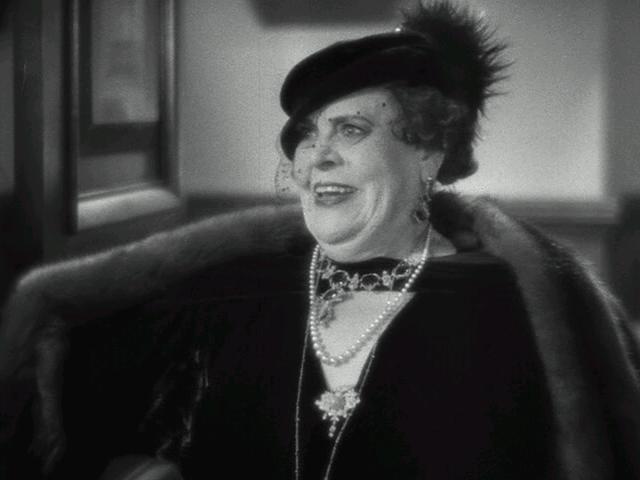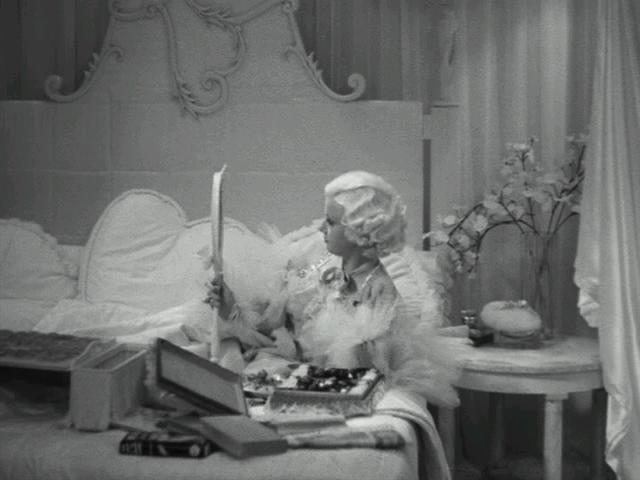|
Genres, Themes, Actors, and Directors:
- Comedy
- Ensemble Cast
- George Cukor Films
- Get Togethers and Reunions
- Has-Beens
- Jean Harlow Films
- John Barrymore Films
- Karen Morley Films
- Lionel Barrymore Films
- Marie Dressler Films
- Play Adaptations
- Social Climbers
- Wallace Beery Films
Response to Peary’s Review:
As Peary notes, this “serious-at-the-core comedy” — featuring a “once-in-a-lifetime ensemble” cast — effectively shows how “women are able to adapt to their situations, overcoming their problems and taking control, while the man always are more passive.” Indeed, it’s the female actresses here — Harlow, Dressler, and Burke — who are the highlights of this surprisingly unfunny tragi-comedy, directed in an overly stagy and static fashion by famed “women’s director” George Cukor. The scenes between Harlow (who spends most of her time lounging in bed) and Beery are full of plenty of zingy one-liners, but their characters are so unappealing that it’s difficult to enjoy spending time with them. The same goes for Burke’s stressed-out housewife, who is so absorbed in social concerns that she neglects to notice her husband’s ailing health, and thus loses our sympathy as well. While Peary argues that “every expression and line by Dressler, whose talents have been forgotten by too many” is a comic gem, even her presence can’t quite lift the overall gloominess of the script. Ultimately, one watches Dinner at Eight simply to see so many of MGM’s glamorous stars performing together — and to hear Dressler’s final, classic line delivered to Harlow: “Oh, my dear, that’s something you need never worry about.”
Redeeming Qualities and Moments:
- Marie Dressler as the aging actress in financial distress

- Jean Harlow as the manipulative, social-climbing “Kitty”

- Billie Burke, perfectly cast as the nervous socialite housewife

- Luminous cinematography and art deco sets

Must See?
Yes. While dated and not nearly as funny as it should be, this remains a classic MGM ensemble film which should be seen by all film fanatics. Nominated by Peary for an Alternate Oscar as best picture of the year.
Categories
Links:
|





2 thoughts on “Dinner at Eight (1933)”
Not a must. ‘DAE’ is considered a classic, and there’s good reason for that: with its cast and gussied-up design, it has the veneer of pedigree.
But try sitting through it. Not that it’s bad…just not all that good.
The script’s structure is solid – it’s like an early ‘Nashville’, in which a number of characters with their own storylines will come together at the end – but the dialogue is often soggy or just plain old. Most of the actors do their best to compensate – or over-compensate; lacking material to trust, some (Dressler, John Barrymore, Burke – the last bordering on insanity…again) overplay. The film only comes to life (not often enough) with dependable Lionel Barrymore and the Beery and well-decked-out Harlow characters – who pre-date Broderick Crawford and Judy Holliday in ‘Born Yesterday’.
Director Cukor handles the scene with the physician and his wife as if it had personal meaning.
Rather than building to a finale, ‘DAE’ weakens as it progresses, and the ending – when all appears to fall through and it’s just g-h-a-s-t-l-y for everyone – is not very effective. What’s most odd is the famous final exchange between Harlow and Dressler: it is indeed hilarious but, in terms of script consistency, it comes out of nowhere and belongs in a completely different – and funnier – movie.
A once must for the cast, director, and its place in history. I did find myself looking at the time at times since it dragged (or I was put off with some of the actions).